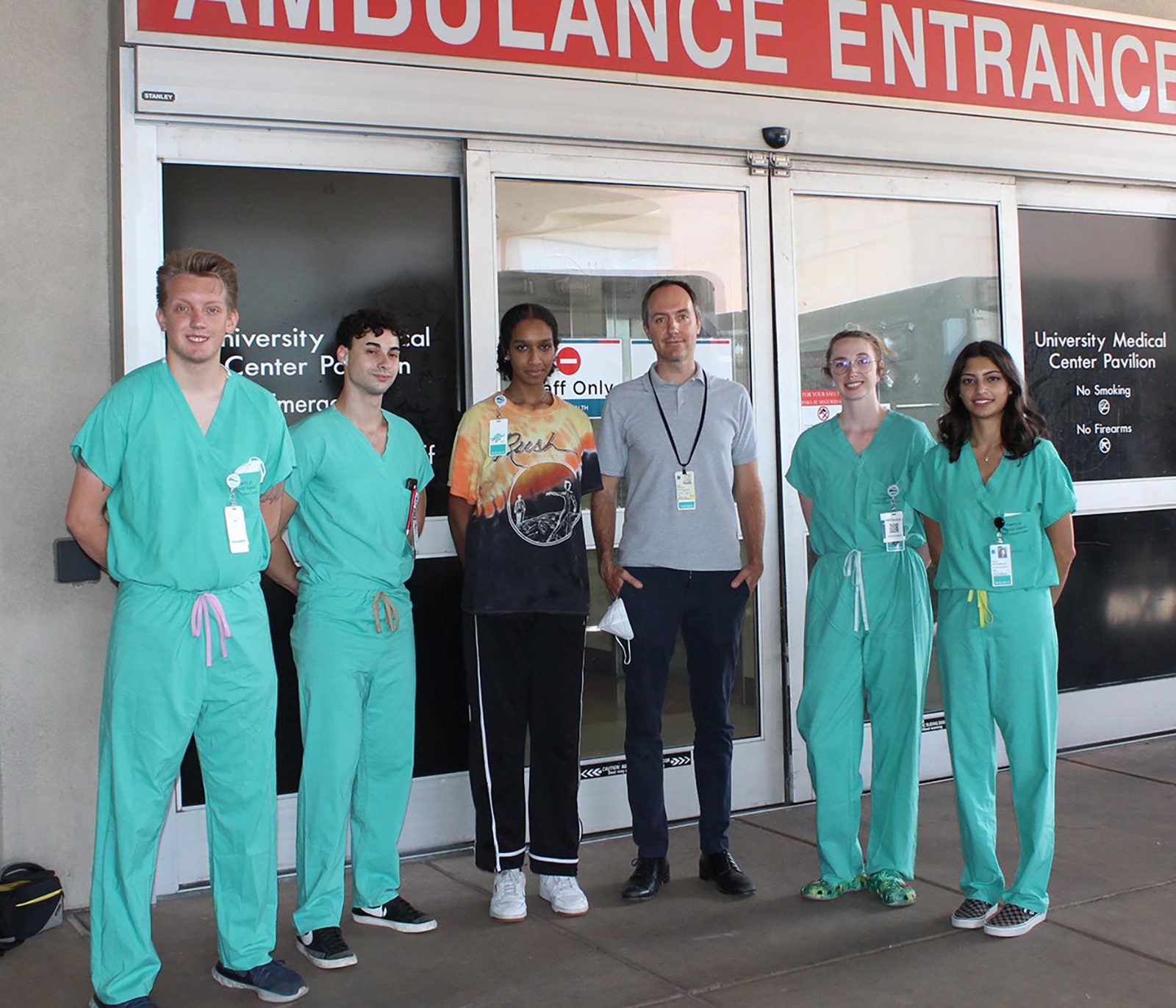
From left: Research in Acute Care participants Xander Augustson, undergraduate research assistant; Tom Limanovich, professional intern research coordinator; Munia Omer, undergraduate research assistant; Silas Bussmann, associate director for Research in Emergency Medicine; Sarah Lavelle, research coordinator; and Muskan Katoch, undergraduate research assistant.
A program at The University of New Mexico Department of Emergency Medicine allows students to participate in hands-on clinical research while working with staff and patients in the UNMH Emergency Department. The multi-semester course, Research in Acute Care, is open to undergraduate students, as well as others interested in careers in healthcare and affiliated fields and gives them a chance to work closely with physicians and staff and interact with patients.
What has long been commonly called the “emergency room” is in reality a whole department at UNM Hospital now, said Silas Bussmann, associate director for research at the UNM Department of Emergency Medicine.
“It’s so much bigger than a room now,” he said, with about 90 individual rooms, a 70-bed adult emergency department, and 12-bed pediatric unit, with specialized areas for patients with respiratory problems, those under observation, or those with psychiatric complaints. The emergency department gets over 100,000 unique visits a year.
“Which is part of why they’re building a new hospital,” he observed.
In an emergency department that is open 24/7/365, it’s difficult to staff and do research, epidemiological monitoring, quality assurance, and observational data collecting with the current budget, Bussmann explained. So, department faculty and administration decided to create an educational activity with structured learning around research, research design, and research implementation, specifically in a hospital clinical environment because a lot of health science students wanted experience in that area.
“We get a lot of undergrad students who are interested in careers in healthcare or affiliated fields, who want to see if they are interested in getting into the emergency department, to get the experience of doing research and being in a clinical environment and talking to patients, and also contributing to institutional and departmental public health and research initiatives,” he said. A strong background in basics of the sciences such as chemistry and biology is helpful, as well as an understanding of general public health problems and social determinants of health.
“There are plenty of research design courses and research theory courses available on main campus, but very few courses where you’re actually doing research, your own or other people’s and even fewer courses still in a clinical environment so that’s really what we were targeting. I don’t think any other department has been bold enough ̶ or foolish enough ̶ to try to put undergraduates in the clinical environment to be able to operate independently and interact with patients. We do that and it takes a heavy component of mentorship but that is our duty as an educational institution and I don’t think there are any research courses on campus that prepare people as well for doing FDA-regulated human subjects research than this course,” Bussmann remarked.
In the course, students shadow emergency department physicians and staff and are independently responsible for screening or looking out for patients in the clinical environment, complemented by a classroom component where they are taught research design and compliance. They also may get other duties assigned as they show aptitude.
“We expect that they will have access to all the areas of the emergency department and strongly encourage them to spend time in all those areas… We strongly encourage them to shadow different job roles and areas,” Bussmann said. “I tell them that one of the most interesting to do is shadow a charge nurse, the nurse in charge of a particular shift, because they have to solve a lot of the healthcare system issues on that shift that allow the emergency department to function.”
Students who complete the course come away with a solid background in research and how patients are taken care of in an emergency department, and well prepared for further, more formal, medical training. Students will come away from the class having enrolled a patient in a clinical research study. Career opportunities abound.
Past students have participated in a range of research projects, including emergency department patient satisfaction and wait time expectations, impact of the Affordable Care Act on patient decision-making, and emergency department patient alcohol misuse.
Bussmann cited former student Kisa King as a success story from the Research in Acute Care program. King completed the course prior to attending medical school at UNM, went on to complete residency in the Department of Emergency Medicine at Stony Brook University Hospital on Long Island in New York, and recently returned to UNM as faculty. She made the news in 2020 when she became the first Stony Brook hospital worker to receive the new COVID vaccine.
King is now an assistant professor in the UNM Department of Emergency Medicine, where Bussmann hopes she will teach undergraduate medical students.
“Emergency departments were really this frontline when COVID came. They needed to be the most ready, and the most expandable for meeting the healthcare demands that the pandemic brought. So, emergency medicine is expanding very quickly and a lot of the ways in which there are opportunities for advancements in healthcare at this point are to expand the availability of urgent care and emergency care services.”
Emergency departments are growing incredibly fast and have become a more central part of how the healthcare system functions. As there is a growing deficit of family practice and primary care providers, wait times for appointments extend weeks or even months, and patients depend more on emergency and urgent care scenarios, Bussmann said. One of the main objectives of the course is to introduce students to this area of healthcare while learning about its opportunities and challenges through performing research.
For details about the program and enrolling, check the website.
